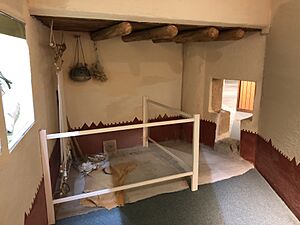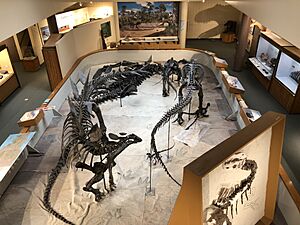USU Eastern Prehistoric Museum facts for kids
| Former name | College of Eastern Utah Prehistoric Museum |
|---|---|
| Established | 1961 |
| Location | Price, Utah |
| Type | Science, Natural History |
The Prehistoric Museum, USU-Eastern is a cool museum in Price, Utah. It used to be called the College of Eastern Utah Prehistoric Museum. This museum helps everyone learn about prehistoric times. It does this with awesome exhibits, fun programs, and by studying old things. The museum is in a special area called Castle Country. This area has many places where scientists find ancient bones and artifacts. These places include the San Rafael Swell and canyons like Nine Mile Canyon.
Contents
Discovering the Past: Museum History
The Prehistoric Museum started in 1961. It was a team effort between the College of Eastern Utah and the town of Price. On May 8, 1961, the museum was officially created. At first, the college's geology department helped fund it. The museum first opened to the public on June 3, 1961. It was in a small room on the second floor of the Price Municipal Building.
The museum quickly grew bigger. It expanded into the hallways of City Hall. Then, in 1971, it moved into the old city gymnasium. Later, the State of Utah started providing money for the museum. In 1990-1991, the museum got a lot more funding. This was because it was expanding a lot. A new part was opened, which became the Hall of Dinosaurs.
Over its history, the museum has grown quite a bit. It is now a 25,000 square foot building. It also has a 6,000 square foot storage area. This area is used for preparing fossils.
Exciting Dinosaur Discoveries
Since 1990, the museum has been doing a lot of fieldwork. Scientists have found 12 new types of dinosaurs. They have also found over 7,000 fossil specimens. In 1991, the museum became officially recognized. This meant it could store collections from all over Utah.
In the 1990s, dinosaurs became very popular. Thousands of visitors came to the museum. They traveled along the Dinosaur Diamond Scenic Byway. New discoveries in Utah have kept interest high. The museum now holds over 750,000 prehistoric items. These come from all around the state.
What Makes the Museum Special?
The Prehistoric Museum is very special. It is recognized by the American Alliance of Museums. Only a small number of museums get this honor. The museum is also a place where federal and state collections are kept. These include both fossils and ancient tools.
The museum has more than 700,000 archaeological artifacts. This is one of the biggest collections in the country. Many of these items are from the ancient Fremont people. These artifacts are known worldwide. The museum's fossil collection is also amazing. It includes new types of fossils never seen before.
Cool Things to See
The museum's collections focus on items found in the local area. Here are some of the cool things you can see:
- Fremont Culture: Learn about the Fremont people. See copies of their rock art. You can also see the famous Pilling Figurines.
- Ice Age Utah: Explore what Utah was like during the Ice Age. See evidence of early humans.
- Huntington Mammoth: This is one of the best-preserved fossil elephants ever found. It's a must-see!
- Utahraptor and More Dinosaurs: See the Utahraptor and many other new dinosaurs. These discoveries add to what we know about dinosaurs around the world.
Museum Exhibitions
The museum has many interesting exhibits. They focus on the prehistory of eastern Utah. There are two main galleries. One gallery shows paleontology and geology. This means it has fossils and rocks. The other gallery shows archaeology. This means it has ancient human artifacts. Both galleries use real items from the region.
Special Art and Rock Art Exhibits
- The Other Side of Utah: This is an annual art exhibit. It started in 2006. It shows art that reflects the Utah area.
- Rock Art Exhibit: This exhibit includes a restored pictograph panel. This panel came from Horseshoe Canyon. This canyon is in Canyonlands National Park.
See also
- Cleveland-Lloyd Dinosaur Quarry — Fossils from this site are shown at the USU Eastern Prehistoric Museum.



